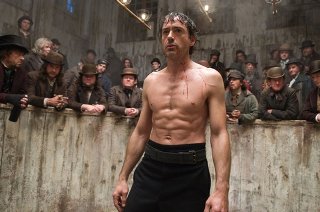I’ve just got back from an enjoyable working holiday in Taiwan, marred only (courtesy of a certain Icelandic volcano) by a detour to Frankfurt and an insanely long coach/ferry journey back to the UK. During that time, my only exposure to ciphers was through China Airlines’ numerous on-demand seat-back films and documentaries: but rather than bore you with my take on Avatar (“Titanic meets The Abyss in a blue paint factory“), here are my thoughts on another film…
Continuing a centuries-long novelistic tradition, film-makers often construct their tortuous plots around enciphered and/or occult texts, particularly when wishing to shorthand a bit of high-speed visual mystery in. Guy Ritchie (the Artist Formerly Known As “Mr Madonna”) proves no exception to this rule of thumb: his “Sherlock Holmes”, painted against a backdrop of Victorian London while its new Tower Bridge was being built, has an inevitably evil protagonist putting the town to fear while taking control of a (you guessed it) centuries-old shadowy masonic cabal through the careful use of theatrical rituals, rhododendron leaf recipes, and occult manuscripts. Oh, and a gigantic steampunk bomb thing, too.
With Ritchie’s Lock/Snatch editing trickery and Holmes transformed into an opiate-free fighting man (using the little known British martial art of ‘bartitsu’, which fans of Sammo Huang may recognize as “walking-stick fu”), there’s plenty of good-ish stuff to keep the screen busy. But ultimately the film is a shallow confection, even compared to Lock & Snatch: Jude Law is just too dull for Watson, while Robert Downey Jr reminded me again and again of Kevin Rowland (co-founder of Dexy’s Midnight Runners) which I’m not really sure is a good thing, however much you like “Come on Eileen”.
Still, if you scrape away all the surface dross (including Holmes’ rather contrived love interest), you do get occasional glimpses of a slightly better story trying to get out – fearfulness and wonder about the technology of the coming (20th) century, the occult as a tool for masking political power (rather than for masking natural powers), etc. It also has to be said that Ritchie’s various clue-tastic high-speed montages do give a surprisingly good feel for the kind of Holmesian intellectual rush Voynich researchers sometimes get when a load of details finally assemble themselves together: basically, when knowledge of real substance somehow forms from the dust-cloud of evidential fragments swirling around you.
Even so, the film as a whole only really convinces as an extended advert for the blatantly upcoming Holmes vs Moriarty sequels. In fact, Professor James Moriarty only ever featured prominently in two Sherlock Holmes stories, so there’s only obviously room for SH II and SH III. Some critics will already be ready to append a “T” to these, perhaps a little unfairly (though not by much).
